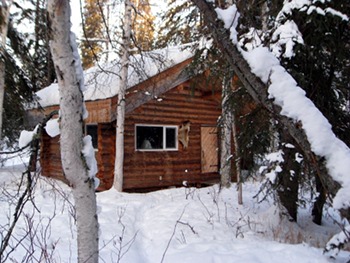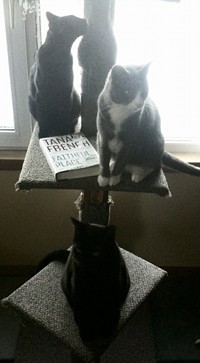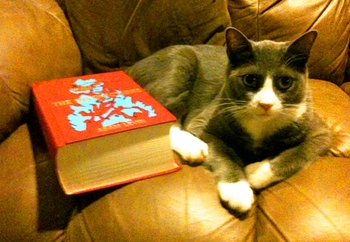Thus far in 2011 I’ve read three books. I finished Paul Auster’s Invisible, and read Girl Factory by Jim Krusoe on New Year’s Day. I read a few raves of the Auster book, and I’d put it in a very long list of his better books. Maybe not in the top five, but one not to miss if you like his writing. Girl Factory was excellent. After I finished it, I wrote to myself: “Highly entertaining, and the main character had a great voice. New favorite book of 2011, one day into it.” Two weeks later and I’ll stick to that opinion.
The book I just finished, while watching the Bears thrash the Seahawks, was Tana French’s Faithful Place. I can’t remember why I picked it up, but I probably should have known by the style of the dust jacket that it wouldn’t be quite my taste. It’s in the crime genre, and was a little too filled with the stock and trade of that category for me. Even so, the characters are spectacularly well fleshed out, and the sense of place was great. I don’t know anything about the lower class rowhouses of Dublin where the action takes place, but I had no trouble filling the blanks from her detailed descriptions.
Anyway, it wasn’t really my thing, but if you enjoy literate crime fiction, this is a book I can recommend.
It’s been a few years since I stopped discussing the books I’ve been reading, and I think I should get back to it again. I find it’s good to write a little (even if it’s just a sentence or two) about what I’ve read; when I don’t, I find that I don’t really think much about what I’ve read. I’m not a particularly critical reader, and I don’t expect that everything I read will need to mean something, but without consideration, many of the books I’ve read just fade into a blurry outline, and eventually disappear from memory altogether.
I’ll start by trying to recollect what I can about the books I read last year. Looking at the list on the right side of the page, it’s pretty easy to put the books into three categories: the best, the next, and the rest.
One comment before getting to the list. I like reading books on paper, rather than electronically, and I like owning the objects themselves. That some publishers (McSweeney’s, Two Dollar Radio, Tin House, for example) actually pay attention to the quality of their books means something to me, and I’m more inclined to buy a book that is typeset well, has a sewn binding, and has attractive cover art, than the crappy “Perfect” binding and shiny raised-print dust jacket that’s typical of most hardcover and paperback books these days. Maybe if companies focused on a quality product, consumers would be more likely to actually buy the thing instead of flocking to a digital version?
The best
The Instructions, Adam Levin
This one is a clear number one for me. It probably isn’t the best book I’ve ever read or anything, but there was so much to like in this book that it’s flaws are easily forgiven. The story, characters, and the way Levin slowly introduces us to the language and mind of 10-year old, possible messiah, Gurion ben-Judah Maccabe was pure pleasure. For example, he’s always talking about “chinning the air” at someone. Whenever I’d come to that phrase in the book, I’d almost involuntarily nod my head the way you greet a friend (or smile at a cat). Gurion’s friendships and the way boys fight and make friends felt real; the love story between Gurion and Eliza June Watermark was touching and painful. And brief descriptions like this:
I chugged my coffee, leaving only one sip. I liked to drink the last sip while I stepped off the train, then victory-spike it into the garbage barrel at the station = I am finished with this part of the day!
Not only is that a great image, but I like how Levin uses the equals sign to relate the actual (left side) with it’s meaning (the right side of the equation). There are a lot of conventions like this that build up through the book.
For me, the primary weakness of the book was the ending. I had a hard time understanding exactly what it was supposed to mean, not just to me, but to the characters. It wasn’t clear why this is the path they’d chosen, or what they’d hoped to accomplish. It’s not unlikely that I missed the signs earlier in the book (it’s over 1,000 pages…); and a second reading would help. But, it’s a minor complaint. It’s hard to know what Levin should have done with all the magic he’d created in the first 900 pages of the book that precede the Gurionic War.
The Thousand Autumns of Jacob de Zoet, David Mitchell
An odd story about an odd time and place: a man-made island in Nagasaki Harbor where the Dutch East India Company traded with Japan at the end of the 18th century, and the unusual mixture of modern and ancient culture. Part love story, part ninja adventure, part bureaucratic intrigue, I really enjoyed inhabiting the world of this book. Mitchell has become one of my favorite writers, and historical fiction really suits him (although it’s possible I’m saying that because I really enjoy historical fiction). I thought the last page of the book was stunning. Pure poetry.
Freedom, Jonathan Franzen
It was pretty hard to miss this book this year, and I felt like it lived up to the hype. From the very first page, the descriptions of the characters, their motivations, and the society we live in was spot on, and often hilarious. The book is the classic love triangle story between Patty, Walter and Richard, spanning their lives, hopes, dreams, and failures. I can’t recall much of a plot, but the story is the characters, and I didn’t find my mind wandering at all.
Skippy Dies, Paul Murray
Another story about a boy, but this one dies in the first few pages, and the rest of the novel recounts how and why he wound up on the floor of the doughnut shop with his friend. Like The Instructions it’s got a love story and conflict, but it deals much more with the pains of adolescence and the failed dreams of adulthood. Great book.
Half a Life, Darren Strauss
When Darren Strauss was 18 he hit and killed a classmate with his car. This book is about how that affected the rest of his life, and how he eventually came to terms with it. I thought it was amazing.
Wolf Hall, Hilary Mantel
Did I mention that I like historical fiction? Wolf Hall treads over familiar ground, King Henry the Eighth and the English reformation, but told from the perspective of Thomas Cromwell. Mantel’s Cromwell is a compelling character; an intellectual in a court of fools, a common man among Lords and Royals, and someone dedicated to his family rather than what his children can bring him. It’s also very interesting to compare the story (and man) presented here with the more common variant (see The Tudors, for example) where Thomas More is the moral hero and Cromwell is the back room dealer working only for his own financial wealth.
My only complaint is that the story isn’t finished. I can’t wait for the next volume.
The next
Norwegian Wood, Haruki Murakami
This is the book that made Murakami so popular in Japan. It’s a love story, but with the usual mystery and magic of Murakami, and is certainly the most erotic of the books of his that I’ve read. Like everything else I’ve read from him: fantastic.
Six Topics in Calamity Physics, Marisha Pessl
The buzz about this book when it came out seemed to be focused primarily on how attractive the author is. Whatever. Great book, and an incredible character in Blue. Observers wonder whether her second novel, due out in August, could possibly be as good without Blue.
Juliet, Naked, Nick Hornby
Bad Marie, Marcy Dermansky
Super Sad True Love Story, Gary Shteyngart
Stoner, John Williams
Talk Talk, T.C. Boyle
The Pesthouse, Jim Crace
Dance Dance Dance Haruki Murakami
A group of books I enjoyed, but don’t remember well enough to make specific comments on them.
The rest
I’m running out of steam here, so for these, check out the listing on the right side of the page (assuming you’re actually at my blog). The only books I can’t recommend with reservations on that list are The Orange Eats Creeps, American Psycho, and Everything is Illuminated. They just didn’t do it for me, and in the case of American Psycho, I wound up skimming much of the second half of it. Once you’ve forced yourself to listen to Bateman’s banal conversations about clothes and watch him rape and murder someone, why would you want to subject yourself to any more of that? Not to mention an entire chapter on how great Phil Collins is. Yetch. I realize this is satire, but please!

Back cabin
I’ve read predictions that this winter will be a strong La Niña period, which means that the tropical eastern Pacific Ocean temperature will be colder than normal. The National Weather Service has a lot of information on how this might affect the lower 48 states, but the only thing I’ve heard about how this might affect Fairbanks is that we can expect colder than normal temperatures. The last few years we’ve had below normal snowfall, and I was curious to find out whether La Niña might increase our chances of a normal or above-normal snow year.
Historical data for the ocean temperature anomaly are available from the Climate Prediction Center. That page has a table of “Oceanic Niño Index” (ONI) for 1950 to 2010 organized in three-month averages. El Niño periods (warmer ocean temperatures) correspond to a positive ONI, and La Niña periods are negative. I’ve got historical temperature, precipitation, and snow data for the Fairbanks International Airport over the same period from the “Surface Data, Daily” or SOD database that the National Climate Data Center maintains.
First, I downloaded the ONI index data, and wrote a short Python script that pulls apart the HTML table and dumps it into a SQLite3 database table as:
sqlite> CREATE TABLE nino_index (year integer, month integer, value real);
Next, I aggregated the Fairbanks daily data into the same (year, month) format and stuck the result into the SQLite3 database so I could join the two data sets together. Here’s the SOD query to extract and aggregate the data:
pgsql> SELECT extract(year from obs_dte) AS year, extract(month from obs_dte) AS month,
avg(t_min) AS t_min, avg(t_max) AS t_max, avg((t_min + t_max) / 2.0) AS t_avg,
avg(precip) AS precip, avg(snow) AS snow
FROM sod_obs
WHERE sod_id=’502968-26411’ AND obs_dte >= ’1950-01-01’
GROUP BY year, month
ORDER BY year, month;
Now we fire up R and see what we can find out. Here are the statements used to aggregate October through March data into a “winter year” and load it into an R data frame:
R> library(RSQLite)
R> drv = dbDriver("SQLite")
R> con <- dbConnect(drv, dbname = "nino_nina.sqlite3")
R> result <- dbGetQuery(con,
"SELECT CASE WHEN n.month IN (1, 2, 3) THEN n.year - 1 ELSE n.year END AS winter_year,
avg(n.value) AS nino_index, avg(w.t_min) AS t_min, avg(w.t_max) AS t_max, avg(w.t_avg) AS t_avg,
avg(w.precip) AS precip, avg(w.snow) AS snow
FROM nino_index AS n
INNER JOIN noaa_fairbanks AS w ON n.year = w.year AND n.month = w.month
WHERE n.month IN (10, 11, 12, 1, 2, 3)
GROUP BY CASE WHEN n.month IN (1, 2, 3) THEN n.year - 1 ELSE n.year END
ORDER BY n.year;"
)
What I’m interested in finding out is how much of the variation in winter snowfall can be explained by the variation in Oceanic Niño Index (nino_index in the data frame). Since it seems as though there has been a general trend of decreasing snow over the years, I include winter year in the analysis:
R> model <- lm(snow ~ winter_year + nino_index, data = result)
R> summary(model)
Call:
lm(formula = snow ~ winter_year, data = result)
Residuals:
Min 1Q Median 3Q Max
-0.240438 -0.105927 -0.007713 0.052905 0.473223
Coefficients:
Estimate Std. Error t value Pr(>|t|)
(Intercept) 2.1000444 2.0863641 1.007 0.318
winter_year -0.0008952 0.0010542 -0.849 0.399
Residual standard error: 0.145 on 59 degrees of freedom
Multiple R-squared: 0.01208, Adjusted R-squared: -0.004669
F-statistic: 0.7211 on 1 and 59 DF, p-value: 0.3992
What does this mean? Well, there’s no statistically significant relationship between year or ONI and the amount of snow that falls over the course of a Fairbanks winter. I ran the same analysis against precipitation data and got the same non-result. This doesn’t necessarily mean there isn’t a relationship, just that my analysis didn’t have the ability to find it. Perhaps aggregating all the data into a six month “winter” was a mistake, or there’s some temporal offset between colder ocean temperatures and increased precipitation in Fairbanks. Or maybe La Niña really doesn’t affect precipitation in Fairbanks like it does in Oregon and Washington.
Bummer. The good news is that the analysis didn’t show La Niña is associated with lower snowfall in Fairbanks, so we can still hope for a high snow year. We just can’t hang those hopes on La Niña, should it come to pass.
Since I’ve already got the data, I wanted to test the hypothesis that a low ONI (a La Niña year) is related to colder winter temperatures in Fairbanks. Here’s that analysis performed against the average minimum temperature in Fairbanks (similar results were found with maximum and average temperature):
R> model <- lm(t_min ~ winter_year + nino_index, data = result)
R> summary(model)
Call:
lm(formula = t_min ~ winter_year + nino_index, data = result)
Residuals:
Min 1Q Median 3Q Max
-10.5987 -3.0283 -0.8838 3.0117 10.9808
Coefficients:
Estimate Std. Error t value Pr(>|t|)
(Intercept) -209.07111 70.19056 -2.979 0.00422 **
winter_year 0.10278 0.03547 2.898 0.00529 **
nino_index 1.71415 0.68388 2.506 0.01502 *
—
Signif. codes: 0 ‘***’ 0.001 ‘**’ 0.01 ‘*’ 0.05 ‘.’ 0.1 ‘ ’ 1
Residual standard error: 4.802 on 58 degrees of freedom
Multiple R-squared: 0.2343, Adjusted R-squared: 0.2079
F-statistic: 8.874 on 2 and 58 DF, p-value: 0.0004343
The results of the analysis show a significant relationship between ONI index and the average minimum temperature in Fairbanks. The relationship is positive, which means that when the ONI index is low (La Niña), winter temperatures in Fairbanks will be colder. In addition, there’s a strong (and significant) positive relationship between year and temperature, indicating that winter temperatures in Fairbanks have increased by an average of 0.1 degrees per year over the period between 1950 and 2009. This is a local result and can’t really speak to hypotheses regarding global climate change, but it does support the idea that the effect of global climate change is increasing winter temperatures in our area.
One other note: the model that includes both year and ONI, while significant, explains a little over 20% of the variation in winter temperature. There’s a lot more going on (including simple randomness) in Fairbanks winter temperature than these two variables. Still, it’s a good bet that we’re going to have a cold winter if La Niña materializes.
Thanks to Rich and his blog for provoking an interest in how El Niño/La Niña might affect us in Fairbanks.
The cabin renovation is basically finished. It took much longer than I expected, but I don’t think we’ll have too much trouble finding a renter before winter really starts.
The last thing we had done was to have the utility pole straightened and the power and phone cables buried from the pole to the house. When we bought the place, the utility pole had been forced out of the ground about four feet and was leaning at least 30 degrees. In addition, the overhead lines from that pole to the house dropped to within a few feet of the ground, and were connected to a second pole that was leaning in a tree. We decided it’d be better to just bury the whole thing past the service drop. Problem was, the day before the work was scheduled, we got 0.8” of rain and when they ran the trencher through the saturated permafrost, it turned the trench into a riverine mud pit. The trench ran right along the cabin, and essentially ruined the front yard and driveway area. Since I was having gravel delivered for our arctic entryway, I decided to get a full truck and have them deliver the extra to the cabin. It’s still a bit of a mess, but I’m hoping that grass and other vegetation will grow up through the gravel where our renters don’t drive on it.
A series of photos taken during the entire renovation can be viewed at Cabin Renovation, Summer 2010.



